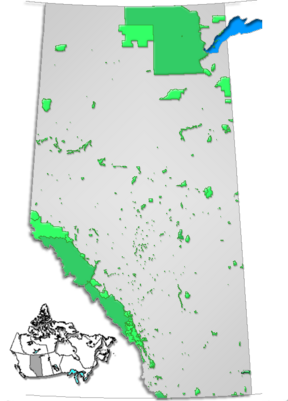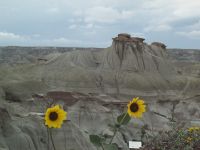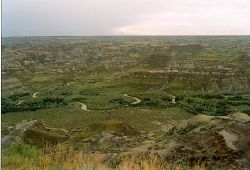Difference between revisions of "Dinosaur Provincial Park" - New World Encyclopedia
Vicki Phelps (talk | contribs) (Import and credit version) |
Vicki Phelps (talk | contribs) |
||
| Line 33: | Line 33: | ||
}}</div> | }}</div> | ||
}} | }} | ||
| − | '''Dinosaur Provincial Park''' is a [[World Heritage Site]] located about a two hours drive east of | + | '''Dinosaur Provincial Park''' is a [[World Heritage Site]] located about a two hours' drive east of Calgary, [[Alberta]], [[Canada]] or {{km to mi|48}} northeast of Brooks. |
| − | The park is situated in the valley of the | + | The park is situated in the valley of the Red Deer River, which is noted for its striking [[badland]]s topography. The park is well known for being one of the greatest [[dinosaur]] fossil beds in the world. Thirty-nine dinosaur [[species]] have been discovered at the park and more than 500 specimens have been removed and exhibited in museums across the globe. Its significance justified it becoming a [[World Heritage Site]] in 1979. |
== History == | == History == | ||
| − | Established on June 27, 1955 as part of Alberta's 50th Jubilee Year with the goal of protecting the fossil bone beds, the first warden was Roy Fowler, a farmer and amateur fossil hunter. | + | Established on June 27, 1955, as part of Alberta's 50th Jubilee Year with the goal of protecting the fossil bone beds, the first warden was Roy Fowler, a farmer and amateur fossil hunter. |
| − | Until 1985 discoveries made in the park had to be shipped to museums throughout the world for scientific analysis and display, including the | + | Until 1985 discoveries made in the park had to be shipped to museums throughout the world for scientific analysis and display, including the Royal Ontario Museum in [[Toronto]], the Canadian Museum of Nature in [[Ottawa]], and the American Museum of Natural History in [[New York]]. This changed with the opening of the Royal Tyrrell Museum of Palaeontology 100 kilometers upstream in the Midland Provincial Park near Drumheller. |
====World Heritage Site==== | ====World Heritage Site==== | ||
Revision as of 02:01, 8 February 2009
| Dinosaur Provincial Park | |
|---|---|
| IUCN Category III (Natural Monument) | |
| | |
| Location: | Alberta, Canada |
| Nearest city: | Brooks |
| Area: | 73.29km² |
| Established: | 1955 |
| Governing body: | Alberta Tourism, Parks and Recreation |
Dinosaur Provincial Park is a World Heritage Site located about a two hours' drive east of Calgary, Alberta, Canada or 48 kilometers (29.8 mi) northeast of Brooks.
The park is situated in the valley of the Red Deer River, which is noted for its striking badlands topography. The park is well known for being one of the greatest dinosaur fossil beds in the world. Thirty-nine dinosaur species have been discovered at the park and more than 500 specimens have been removed and exhibited in museums across the globe. Its significance justified it becoming a World Heritage Site in 1979.
History
Established on June 27, 1955, as part of Alberta's 50th Jubilee Year with the goal of protecting the fossil bone beds, the first warden was Roy Fowler, a farmer and amateur fossil hunter.
Until 1985 discoveries made in the park had to be shipped to museums throughout the world for scientific analysis and display, including the Royal Ontario Museum in Toronto, the Canadian Museum of Nature in Ottawa, and the American Museum of Natural History in New York. This changed with the opening of the Royal Tyrrell Museum of Palaeontology 100 kilometers upstream in the Midland Provincial Park near Drumheller.
World Heritage Site
The park was established as a UNESCO World Heritage Site on October 26, 1979 both for its nationally significant badlands and riverside riparian habitats, and for the international importance of the fossils found here. An official dedication ceremony and plaque unveiling were held at the Park's overview area on June 19, 1980.
Nature
The park boasts a very complex ecosystem including three communities: prairie grasslands, badlands, and riverside cottonwoods. Its ecosystem is surrounded by prairies but is unique unto itself. Choruses of coyotes are common at dusk, as are the calls of nighthawks. Cottontail rabbits, mule deer, and pronghorn can all be seen in the park; the prairie rattlesnake, bull snake and the red-sided garter snake are present as well. Curlews and Canada geese are among the 165 bird species that can be seen in the spring and summer. Some of the most northern species of cactus, including Opuntia (prickly pear) and Pediocactus (pincushion) can be observed in full bloom during the later half of June.
Geology
The sediments of Dinosaur Provincial Park span 2.8 million years and three formations: the terrestrial Oldman Formation at the base of the strata, the terrestrial Dinosaur Park Formation above, and the marine Bearpaw at the top. The Dinosaur Park Formation, which contains most of the fossils from articulated skeletons, was primarily laid down by large meandering rivers in very warm temperate coastal lowlands along the western margin of the Western Interior Seaway. The formation dates to the Late Campanian, about 75 million years ago. The Dinosaur Park Formation spans about 1 million years.
Paleontology
Dinosaur Provincial Park preserves an extraordinarily diverse group of freshwater vertebrates. Fish include sharks, rays (such as the durophage Myledaphus), paddlefish, bowfins, gars, and teleosts. Amphibians include frogs, salamanders, and the extinct albanerpetontids. Reptiles include lizards (such as the large monitor Paleosaniwa), a wide range of turtles, crocodilians, and the fish-eating Champsosaurus. Mammals such as shrews, marsupials, and squirrel-like rodents are also represented, although usually only by their fossilized teeth, rather than bones.
Mega-plant fossils are rare in the park, but pollen grains and spores collected from here suggest that these Campanian forests contained sycamore, magnolia and bald cypress trees, along with Metasequoia.
The dinosaurs of the park are astonishingly diverse. They include:
Ceratopsia
- Leptoceratops sp.
- Centrosaurus apertus,C. brinkmani
- Styracosaurus albertensis
- Pachyrhinosaurus
- Chasmosaurus belli, C. russeli, C. irvinensis
Hadrosauridae
- Corythosaurus casuarius
- Gryposaurus notabilis, G. incurvimanus
- Lambeosaurus lambei,L. magnicristatus
- Prosaurolophus
- Parasaurolophus walkeri
Ankylosauria
- Panoplosaurus
- Edmontonia
- Euoplocephalus
Hypsilophodontidae
- Orodromeus
Pachycephalosauria
- Stegoceras
Tyrannosauridae
- Daspletosaurus sp.
- Gorgosaurus libratus
Ornithomimidae
- Ornithomimus
- Struthiomimus
- new ornithomimid species A
- Chirostenotes pergracilis
- Chirostenotes elegans
- Chirostenotes collinsi
Dromaeosauridae
- Dromaeosaurus
- Saurornitholestes
- ?new dromaeosaur species A
- ?new dromaeosaur species B
Troodontidae
- Troodon
- new troodontid species A
Classification Uncertain
- Ricardoestesia gilmorei
Birds such as Hesperornithiformes were present, as well as giant Pterosauria related to Quetzalcoatlus. Stagodont marsupials, placentals and multituberculates scurried underfoot.
External links
Credits
New World Encyclopedia writers and editors rewrote and completed the Wikipedia article in accordance with New World Encyclopedia standards. This article abides by terms of the Creative Commons CC-by-sa 3.0 License (CC-by-sa), which may be used and disseminated with proper attribution. Credit is due under the terms of this license that can reference both the New World Encyclopedia contributors and the selfless volunteer contributors of the Wikimedia Foundation. To cite this article click here for a list of acceptable citing formats.The history of earlier contributions by wikipedians is accessible to researchers here:
The history of this article since it was imported to New World Encyclopedia:
Note: Some restrictions may apply to use of individual images which are separately licensed.


